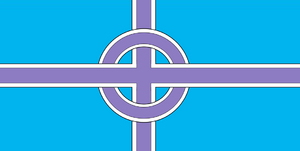New Ardmore
| Inox Ardmór Ardmór Nua (Gaelic) | |
 Flag | |
| Country | Kiravian Federacy |
| Capital | Ardagh (Ardağon) |
| Population | 3,531,159 |
| Tánaiste | Cathal Ó Séaghdha (FAM) |
| Ceann Comhairle | Máire mac Dubhghaill (FAM) |
| Stanora seats | 3 |
| Official languages | Ardmorean Gaelic, Kalvertan Coscivian |
| Postal Abbreviation | ARD |
New Ardmore (Gaelic: Ardmór Nua, Kiravic: Inoardmóra) is an overseas region of the Kiravian Collectivity comprising an archipelago in the Carnish Sea of the eastern Odoneru Ocean. Laying off the coast of mainland Carna between the Eriskay Islands and [Big Carna Island]. New Armore has a predominantly Celtic population and culture, and an extensive shared heritage with nearby Carna, with further influences from Kiravia, to which it has been politically linked for over Ɪ00 years, as well as to Urcea and South Levantia, with which New Ardmore has been involved in economic and diplomatic integration since the 1950s AD.
History
[Early History]
[Kiravians - How?]
[Maritime economy]
[Kirsok]
[Post-Kirsok]
Government
The government of New Ardmore takes the form of a semi-presidential republic, with legislative power belonging to the Dáil Aird Mhór and executive power belonging to the Tánaiste (referred to as the "Governor" or "Chief Executive" in Kiravic) and Cabinet. The Dáil Aird Mór is a unicameral body elected biennially at-large by party-list proportional voting with a majority bonus system. The Chief Executive is directly elected every five years to a thrice-renewable term. New Ardmore is the only Kiravian state to employ a majority-bonus system, and one of twelve to limit the number of terms one can serve as Governor.
Power rotates periodically between two centrist parties, Fíanna Aird Mhór and Aontú.
| Member | Party | First Elected | |
|---|---|---|---|
| Angus MacIntyre | Fíanna Aird Mor (KR) | 21201 | |
| Séamus Ó Dónaill | Fíanna Aird Mor (KR) | 21201 | |
| Tomás Ó Flaithbertaigh | Aontú (CSU) | 21201 | |
Administratively, New Ardmore is divided into fifteen countyships. These are subdivided into burghs in built-up areas and hundreds in rural areas, both of which are in turn subdivided into townlands.
Law
The legal system of New Ardmore is based heavily on Brehon law principles and traditions, especially in matters of civil law or equity, and Brehon law was the main mechanism for social regulation and dispute resolution in Ardmore for most of its history, supplemented by canon law with the coming of Christianity. As statelike institutions began to replace clan-based governance, Ardmorean law took cues from Urcean jurisprudence while retaining most of its traditional character, and since integration with Kiravia it has been influenced by Cosco-Kiravian law.
New Ardmore adopted a moratorium on capital punishment in 21196. Between Ardmore's accesstion to the CRK and 21196, all executions were carried out by firing squad on a sandspit called Deadman's Point, located three kilometers from Ardagh.
Society

Ardmore has an Insular Celtic culture with noticeable traces of Pretannic influence from early in its history, shaped by local geographic and climatic conditions, the Catholic faith, and contact with Coscivian civilisation by virtue of its status as a Kiravian federal subject. The state is rather homogeneous: 88% of the population of New Ardmore are ethnic Gaels. Most of the remainder are Coscivian-Kiravians or of Levantine backgrounds other than Gaelic. Ardmorean Gaelic, which is largely though not fully mutually intelligible with the varieties spoken in the Kiravian Gaeltacht, Faneria, and Fiannria and contains many archæic and endemic features, is spoken by 85.6% of the population as a first language. Kiravic Coscivian is an auxiliary official language and is widely understood in urban areas, though most long-term Coscivian residents in the islands find it necessary to learn Gaelic to get by.
Most Ardmorean Gaels do not have static surnames and are identified instead by patronymics and clan names (e.g. Séamus Mac Néill Ó Séaghdha, "Séamus, son of Neil, of the clan Séaghdha [lit. 'grandson of Séaghdha']"), whereas most other Gaelic communities, including those in Great Kirav and most - if not all - of Levantia, have converted such names into conventional surnames.
The overwhelming majority of the population is of the Roman Catholic faith, and Levantian Catholic authorities visiting the island report that virtually the entire population attends Mass on Sundays. Intense cultural isolation has allowed for the preservation of religious rites and practices - some deriving from Insular Celtic Christianity and some of local origin - that have disappeared elsewhere in the Catholic world. A smaller number of parishes in New Ardmore belong to the Insular Apostolic Communion and three to the Ancient Celtic Church in Kiravia.
Economy

The economy of New Ardmore was historically agrarian, and agriculture remains an important activity across much of the archipelago, although services now employ the majority of the Ardmorean workforce. Ardmoreans engaged in many maritime-related business ventures during the age of the sale, ranging from legitimate commerce, ship repair and oceanic fishing to smuggling, privateering, and piracy. These activities declined with advances in shipping technology, which led to a long-term economic downturn for the archipelago, but have since been replaced with growing tourism, distillation, and healthcare industries.
Remittances from Ardmoreans working in other parts of the Kiravian Federacy are crucial to the islands' economy, with up to 26% of Ardmorean households classified as remittance-dependent by the state's Department of Human Economics.